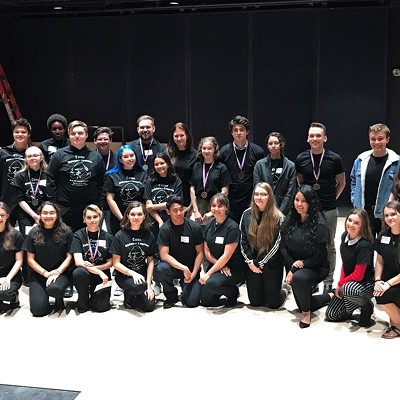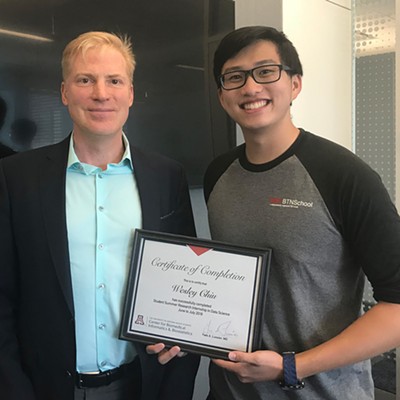Money matters little, if at all, in such contests, for when the well-off suburban kid steps on the court or the field against the struggling inner-city kid, he doesn't get to bring his accountant or his bankbook or his daddy's lawyer. It boils down to who's the better athlete, who has trained harder and who wants it more. It's Hoosiers writ large across a sports-loving nation that bills itself as the ultimate land of opportunity.
Well, you can throw that one on the scrap heap of debunked conventional wisdom, along with "manners will catch up with cell-phone technology," "rap music is just a passing fad" and "George W. Bush will realize that he lost the popular vote in 2000 and make a conciliatory move toward the political center."
A recent wide-ranging survey conducted by USA Today shows that, across the nation, public schools in higher-income areas dominate the prep sports landscape, often winning championships at a ratio of 10:1 or greater over lower-income schools. Indeed, in 26 of the 27 states surveyed (including Arizona), the higher-income public schools outpace middle- and lower-income schools by wide margins, and, in most cases, also out-perform parochial and other private schools, even though these latter institutions often benefit from a variety of advantages, including recruitment of top-notch athletes.
This trend is also playing out here in Tucson, where Catalina Foothills High School--unquestionably the "richest" public high school in Southern Arizona--has become, in its 10 years of existence, an absolute monument to prep sports excellence. In the past few years, it has zoomed past the previous front-runner, Salpointe Catholic, to become the undisputed leader in this area.
There are many reasons for the growing discrepancy between haves and have-nots, but several of those reasons can simply be traced back to money, and what it can buy.
"It's really just a matter of opportunity," says long-time Amphitheater High School football coach Vern Friedli, who, late in this upcoming season, should become the first Arizona prep football coach to post 300 career victories. "Kids who come from families that have money simply have more opportunities, and that's fine. That's American."
In many ways, Friedli is uniquely qualified to comment on this trend. He has been at Amphi since 1976 and has witnessed the school (and Tucson in general) undergo significant socioeconomic shifts during the past three decades. When he started at the northside school, Catalina Foothills High was still in the early stages of heated debate among people who lived in that district. High school kids who lived in the foothills were scattered among Amphi and Canyon del Oro high schools in the Amphi District, and Catalina and Sabino high schools in Tucson Unified School District No. 1.
"We had a lot of (foothills-area) kids back then," says Friedli, "and frankly, it affects the way the entire school operates. When you have a core of highly motivated kids with high expectations and great parental support and involvement, it just raises the bar for everybody involved. You simply can't overstate the impact that has. That's not to say you can't have motivated kids and involved parents who live someplace else--we get them all the time. But this was a high concentration."
The USA Today survey, which used median-income statistics provided by each state, divided public schools into four (equal in number for each state) categories, ranging from most affluent to least affluent. It then counted the number of team state championships won between 1999 and 2003 in "major" sports, including football, softball, baseball, and boys' and girls' basketball and soccer. The results were stunning.
In Kentucky, 61 percent of all state championships during those years were won by the "most-affluent" public schools, as compared to only 4 percent won by the "least-affluent" schools. In South Dakota, the margin by percentage was 59-9; in Illinois, 58-16; in Montana, 52-15; in Maine, 52-14; and in Arkansas, 51-7.
Here in Arizona, 37 percent of all state championships were won by the most-affluent schools, as compared to only 11 percent by the least affluent. This margin was fairly representative of what happened across the country. In three states, however--Alabama, Louisiana and Vermont--the margins were within single digits, and in Rhode Island, more championships were won by the least-affluent schools (35 percent) than by the most affluent (22 percent).
The division is even more acute in girls' athletics--in several states, more than 90 percent of all state championships were won by teams from the most-affluent schools.
While many parents and athletes are reluctant to buy into (pun intended) the money-athletic success link, most coaches and athletic directors on both sides of the financial divide have no problem talking about it. A coach from New Jersey, who was interviewed for the USA Today article, likened the difference between poor and rich schools to "Dorothy going from black-and-white Kansas to Technicolor Oz. The difference you see in facilities and parental support is like night and day. Sometimes you find better pure athletes in city schools, but they don't always get the same opportunities suburban kids do."
And when coaches use the term "opportunity," it's not merely about having a nicer pair of Nikes or more meal money for away games. It's about approaching high school sports as a quasi-professional endeavor. By the time many kids enter their freshman year, they've been playing their various sports for more than half their lives. Plus, a lot of them will have been doing so on so-called "travel" teams, which can cost thousands of dollars per year. (Travel teams are a racket pulled on gullible parents who are somehow convinced that having their kids play at the local diamond or gym isn't good enough and that--in order to get the full athletic experience before their baby teeth are all gone--the little tykes have to travel to tournaments in Las Vegas or Southern California to play against other 8-year-olds who don't have a clue.)
Many of these travel teams are gold mines for their operators, and it is therefore no surprise that the "travel" season (which, in most sports--including softball, basketball and soccer--used to coincide with summer vacation) is now virtually year-round. This has the effect of forcing kids into becoming one-sport athletes. So, while the girl at the mid-level school might go from the volleyball court to the basketball court and then to the softball diamond, she might be playing against three different sets of kids, each of whom plays that one sport on a year-round basis.
But even that is merely a small part of the story. At Scottsdale (Ariz.) Chaparral High School--where the median family income is $132,000, more than triple the state average--it's estimated that more than half of the school's athletes have individual personal trainers. Some have multiple trainers, one for general fitness and another for specialized instruction in the sport of their choosing. These trainers don't come cheap, either, and those who have a record of success can become the object of a bidding war between parents.
(One former University of Arizona women's basketball player, who asked not to be named, said that she is considering quitting her job, working with kids, and going into 1-on-1 training full time, because she could make considerably more money than she's making now; some trainers make upwards of $50 an hour.)
Taking things a step further, some prep baseball players are known to have several trainers, including hitting instructors, throwing coaches, running trainers and so on.
Throw in the general advantages of money--better nutrition and access to health care, no shelter or transportation woes, and help available to those with academic problems--and the chasm widens even more.
Meanwhile, as the Phoenix metropolitan area continues to grow ever outward, like tree rings being added to a tree, the builders of new schools try to outdo one another in terms of athletic facilities. Many have nice chemistry labs and cafeterias, but their gymnasiums and weight rooms look like absolute shrines to athletics.
Vern Friedli likes to tell the story of Craig Barker, who played for Amphi in the late 1970s. Barker was the son of a lawyer, and during the summer before his senior year, he was given the opportunity to work in his dad's law office. Instead, he chose to work for the city of Tucson, digging ditches. It was hot, tough work, but he showed up for football practice a chiseled beast. Barker made all-conference and all-city and went on to play for the UA.
Nowadays, Friedli sometimes has trouble getting all of his players together at one time, because so many of them are working full-time jobs, some even during the season. "And these guys aren't working just so they can get a nicer car or a bigger stereo," explains Friedli. "They're working to help put food on the table for themselves and their brothers and sisters. It's pretty hard to make football a priority under those circumstances." (Nevertheless, under Friedli, Amphi has won 21 conference championships in 27 years; has made three trips to the state championship game, winning once; and last year defeated much-larger district rival Canyon Del Oro for the 10th time in 11 years.)
Ten years ago, when Catalina Foothills High was in its infancy, the prep powerhouse in Tucson was Salpointe Catholic. The school's coaches did a good job of recruiting throughout Pima County, and the Lancers had strong teams in boys' and girls' soccer, softball and baseball, as well as boys' basketball, girls' volleyball and most of the "minor" sports (golf, tennis, cross country and swimming).
Salpointe continued to dominate through much of the 1990s, but as the millennium came and went, a noticeable shift took place: Catalina Foothills became the model for athletic excellence in town. The school was designed and built with the students in mind, and the sports facilities are nothing short of jaw-dropping. Watching a football game on Falcon Field is like a religious experience, with the field carved out of a hill and the city lights of Tucson glistening far below. The baseball and softball fields are immaculate, and the gym is big enough for three full-court games to be played side-by-side. Even the weight and training rooms are state-of-the-art.
Last school year, Foothills won Class 4A Kino Conference titles in both boys' and girls' swimming, basketball, cross country, tennis, golf and soccer, as well as in baseball and girls' volleyball. Because of and/or despite the school's across-the-board excellence, Foothills is viewed in a positive light by many local people involved in prep athletics. Says one rival coach, pretty much summing up the view of a lot of his peers, "Foothills is like Salpointe used to be ... without the smugness."
This is not to say that Salpointe has completely dried up and blown away. Competing in the 5A-South, Lancer teams did well in boys' and girls' volleyball, tennis, golf, swimming and basketball. But the once-powerful softball team has become an also-ran, and the baseball team barely made the regional playoffs; the football team finished first in the conference, but its season (and post-season) was scandal-ridden and embarrassing.
It fits the pattern, then, that the two top athletic schools in Tucson are those that are generally considered to be the "richest." Rebecca Chilton Peoples, who used to coach both boys' and girls' high school basketball here in Tucson--and is now an assistant women's coach at Arkansas State University, of the Sun Belt Conference--has witnessed the national trend up close.
"The days of inner-city kids flocking to college campuses may be going away," says Peoples, whose duties include recruiting. "A lot of the kids we go after these days are from the higher-end schools. These kids are often more experienced, more polished and more disciplined. You can certainly debate how much of that is (directly attributable) to money, but I think I can safely say it plays a part.
"Plus," she continues, "these days, if an inner-city kid is real good, she'll get hooked up with a club team; some 'benefactor' will pay her expenses, and, more often than not, she'll end up playing for the Catholic school or the rich public school on open enrollment. That's just the way it is."
While the link between money and prep athletic success appears to be well established, many young athletes and their parents bristle at the widespread perception that it is some immutable guarantor of success.
UA sophomore Amelia Fiastro, 19, played soccer at Catalina Foothills High School. She finds the statistical link between household income and championships interesting, but not completely conclusive.
"I'm sure you could find statistics to back up just about any argument, especially when it comes to money," Fiastro says. "At Foothills, we just had what I guess you could call an atmosphere of success. A lot of kids had parents who are successful, but I don't think that the parents push the kids. It's more like the kids are around successful people and they pick up the attitudes and positive habits of successful people.
"Money can do a lot of things, but it can't do your work for you. I was still the one who had to do the sprints and lift the weights and run the bleachers. I was the one who had to kick the ball around the field on the hot summer days and to show up at practice on those cold winter mornings. I guess people could argue that money paid for the alarm clock I used to get up in the morning and the car my mom used to drive me to practice, but it had very little to do with the soccer player I became."
Like many high school athletes, Fiastro played on a club team during the off season, but hers was somewhat unique: Unlike a lot of the outrageously priced clubs that cost players and their parents thousands of dollars a year in team dues, travel expenses, coaches' salaries and so on, Fiastro played on a club team (United) that had volunteer coaches and only collected money to pay tournament entry fees. "We still did really well," she says, "because we had a lot of girls who just liked to play hard."
Pete Fajardo, the girls' basketball coach at Salpointe Catholic, agrees with Fiastro's sentiment.
"Successful kids are the ones who work the hardest," Fajardo says. "It doesn't matter if both parents are doctors or they're both plumbers. No, wait! Plumbers probably make more than doctors!" He flashes a quick smile at his own joke. "But anyway, more important than money is the amount and type of parental involvement. Coaches like to sit around and swap horror stories of parents from hell, but they really are the exception. There's no way to overstate the contribution of involved parents. They run the snack bar; they help with fund raising; they drive kids around; and they show up for games. That's what helps kid be successful. Money helps some, but parents are often the key.
"The stereotype used to be of the overzealous parents trying to live vicariously through their kids. But now, that has morphed into parents who are successful adults trying to give their kids every opportunity to succeed. And what better and easier way to measure instant success than through sports?"
With school just starting for the new school year, and the first prep baseball game more than five months away, members of coach Jason Hisey's Catalina Foothills baseball team are showing up at 6:30 a.m. on Wednesday mornings for conditioning. This, along with weight-training sessions at the school and at a local fitness club, will continue through the fall and winter and into the spring.
Foothills lost in the state championship baseball game this past May after having won its fourth consecutive conference title a week earlier. Still, this year's league championship wasn't determined until the last week of the season, when the Falcons pulled out an 11-10 victory over Amphi on a blustery night.
Did money win that game for them? Or was it all those Wednesday mornings of showing up for sprints and conditioning before school started? Or those nights in the weight room? Or those Saturdays with the extra batting practice?
Todd Judge, who played baseball and football at Columbine High in Colorado and then baseball in college, says, "To a man, I'll bet those guys believe that their success can be traced directly back to those early-morning workouts and their dedication to their teammates and the sport."
As for the question of money, he says, "It (money) can make a kid's life a little bit easier by taking away some of the things that they might have to worry about, but it can also lead to distractions that other kids might not have. They might want to drive around in their car or play video games or go shopping. In a way, a kid with money has to be really dedicated to play a sport at a high level."
If every rule has an exception, then Tucson's is a doozy. (Wait, is it a rule that every rule has an exception, and, if so, what's the exception to that rule?) Down on the southside, less than a mile from the airport, sits Sunnyside High School. Its median annual income is well below the state average; it has hundreds of non-English-speaking students and decent, but not overwhelming, facilities. Also at Sunnyside are the trophies for having won two of the past three 4A state titles in football. There is also an entire wing of the trophy area devoted to a wrestling program that has won a mind-boggling 22 state championships in the past 29 years--and they were the runners up the other seven. The baseball team is a perennial power and has sent several players into the professional ranks.
Sunnyside Principal Raúl Nido, who won state track championships in the 1980s when he was coaching at Amphi, thinks he knows the reason for Sunnyside's success.
"The coaches can't just be enthusiastic; they have to be almost obsessed. They have to be willing to do almost anything to get the kids to succeed. The coaches put in the extra time and the extra work, and the kids follow that."
Nido has heard the statistics about the success of wealthier schools and doesn't dismiss it.
"It's true what parental involvement and money can do," he says, "but we use that to our advantage. We have parental involvement down here, too, and we tell the kids that they have to work that much harder to overcome the advantages that other kids have."
So, in 21st-century America, money talks in high school sports, and it often talks quite loudly. But we haven't yet reached the point where it always gets the last word.














